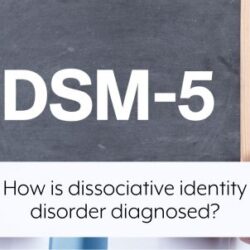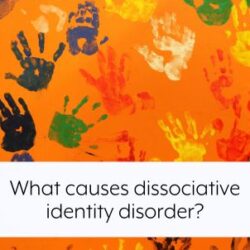| CODE |
DISORDER |
DIAGNOSTIC CRITERIA |
| 300.6 |
Depersonalisation / Derealisation Disorder |
- The presence of persistent or recurrent experiences of depersonalisation, derealisation or both.Depersonalisation: Experiences of unreality, detachment, or being an outside observer with respect to one’s thoughts, feelings, sensations, body, or actions (e.g. perceptual alterations, distorted sense of time, unreal or absent self, emotional and/or physical numbing.)
- Derealisation: Experiences of unreality or detachment with respect to surroundings (e.g. individuals or objects are experienced as unreal, dreamlike, foggy, lifeless, or visually distorted.)
- During the depersonalisation or derealisation experiences, reality testing remains intact.
- The disturbance is not attributable to the physiological effects of a substance (e.g. a drug of abuse, medication) or other medical condition (e.g. seizures).
- The disturbance is not better explained by another mental disorder.
|
| 300.12&13 |
Dissociative Amnesia (DA) with or without Dissociative Fugue (DF) |
- An inability to recall important autobiographical information, usually of a traumatic or stressful nature, that is inconsistent with ordinary forgetting. Note: Dissociative Amnesia most often consists of localised or selective amnesia for a specific event or events; or generalised amnesia for identity and life history.
- The symptoms cause clinically significant distress or impairment in social, occupational, or other important areas of functioning.
- The disturbance is not attributable to the physiological effects of a substance.
- The disturbance is not better explained by dissociative identity disorder.
- Specify if: With Dissociative Fugue: Apparently purposeful travel or bewildered wandering that is associated with amnesia with Dissociative Fugue.
|
| 300.14 |
Dissociative identity disorder |
- Disruption of identity characterised by two or more distinct personality states, which may be described in some cultures as an experience of possession. The disruption in identity involves marked discontinuity in sense of self and sense of agency, accompanied by related alterations in affect, behaviour, consciousness, memory, perception, cognition, and/or sensory-motor functioning. These signs and symptoms may be observed by others or reported by the individual.
- Recurrent gaps in the recall of everyday events, important personal information, and/or traumatic events that are inconsistent with ordinary forgetting.
- The symptoms cause clinically significant distress or impairment in social, occupational, or other important areas of functioning.
- The disturbance is not a normal part of a broadly accepted cultural or religious practice. Note: In children, the symptoms are not better explained by imaginary playmates or other fantasy play.
- The symptoms are not attributable to the physiological effects of a substance (e.g. blackouts or chaotic behaviour during alcohol intoxication or other medical condition, e.g. complex partial seizures.)
|
| 300.15 |
Other Specified Dissociative Disorder |
This was formally the DDNOS category. An individual who does not meet the full criteria for one of the above disorders will be given a diagnosis of OSDD. This category applies to presentations in which symptoms characteristic of a Dissociative Disorder that cause clinically significant distress or impairment in social, occupational, or other important areas of functioning predominate, but do not meet the full criteria for any of the disorders in the Dissociative Disorder class. The Other Specified Dissociative Disorder category is used in situations in which the clinician chooses to communicate the specific reason that the presentation does not meet the criteria for any specific Dissociative Disorder. This is done by recording “other specified Dissociative Disorder” followed by a specific reason (e.g. “Dissociative Trance.”)
Examples of presentations that can be specified using the this designation include the following:
- Chronic and recurrent syndromes of mixed dissociative symptoms: This category includes identity disturbance associated with less-than-marked discontinuities in sense of self and agency, or alterations of identity or episodes of possession in an individual who reports no dissociative amnesia.
- Identity disturbance due to prolonged and intensive coercive persuasion: Individuals who have been subjected to intensive coercive persuasion (e.g. brainwashing, thought reform, indoctrination while captive, torture, long term political imprisonment, recruitment by sects/cults or by terror organisations) may present with prolonged changes in, or conscious questioning of, their identity.
- Acute dissociative reactions to stressful events: This category is for acute transient conditions that typically last less than 1 month and sometimes only a few hours or days. These conditions are characterised by constriction of consciousness, depersonalisation, derealisation, perceptual disturbances (e.g. time slowing, macropsia), micro-amnesias, transient stupor, and/or alterations in sensory-motor functioning (e.g. analgesia, paralysis.)
- Dissociative trance: This condition is characterised by an acute narrowing or complete loss of awareness of immediate surroundings that manifests as profound unresponsiveness or insensitivity to environmental stimuli. The unresponsiveness may be accompanied by minor stereotyped behaviours (e.g. finger movements) of which the individual is unaware and/or that he or she cannot control, as well as transient paralysis or loss of consciousness. The dissociative trance is not a normal part of broadly accepted collective cultural or religious practice.
|
| 300.16 |
Unspecified Dissociative Disorder |
This category applies to presentations in which symptoms characteristic of a Dissociative Disorder that cause clinically significant distress or impairment in social, occupational, or other important areas of functioning predominate, but do not meet the full criteria for any of the disorders in the Dissociative Disorder class. The Unspecified Dissociative Disorder category is used in situations in which the clinician chooses not to communicate the specific reason that the criteria are not met for a specific Dissociative Disorder, and includes presentations for which there is insufficient information to make a more specific diagnosis (e.g. in emergency room settings.) |



